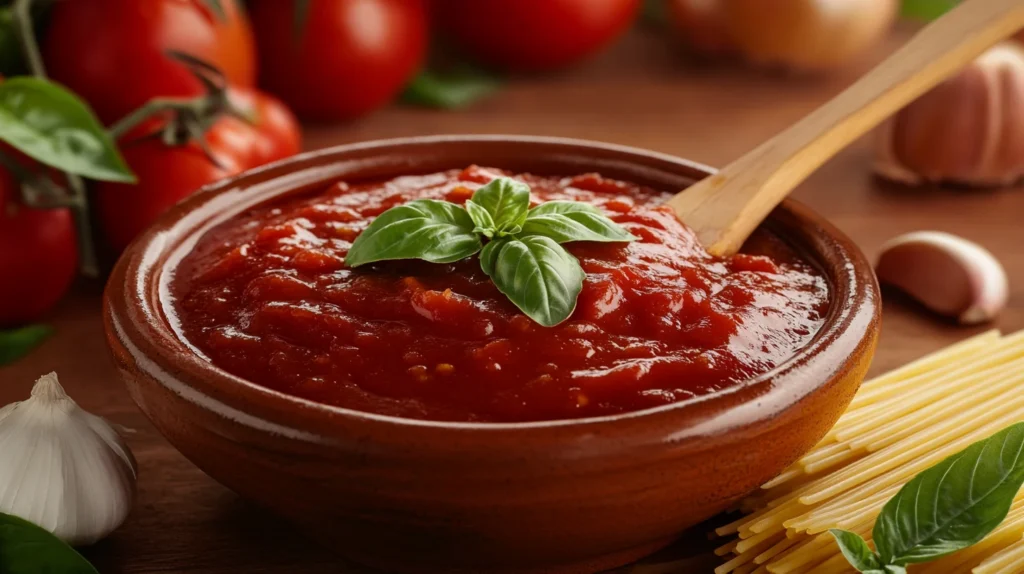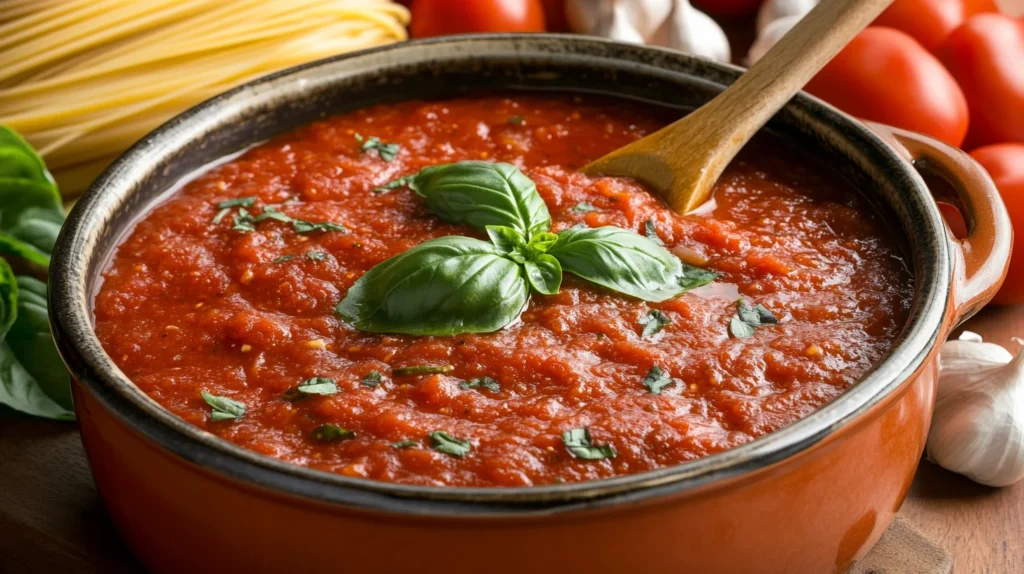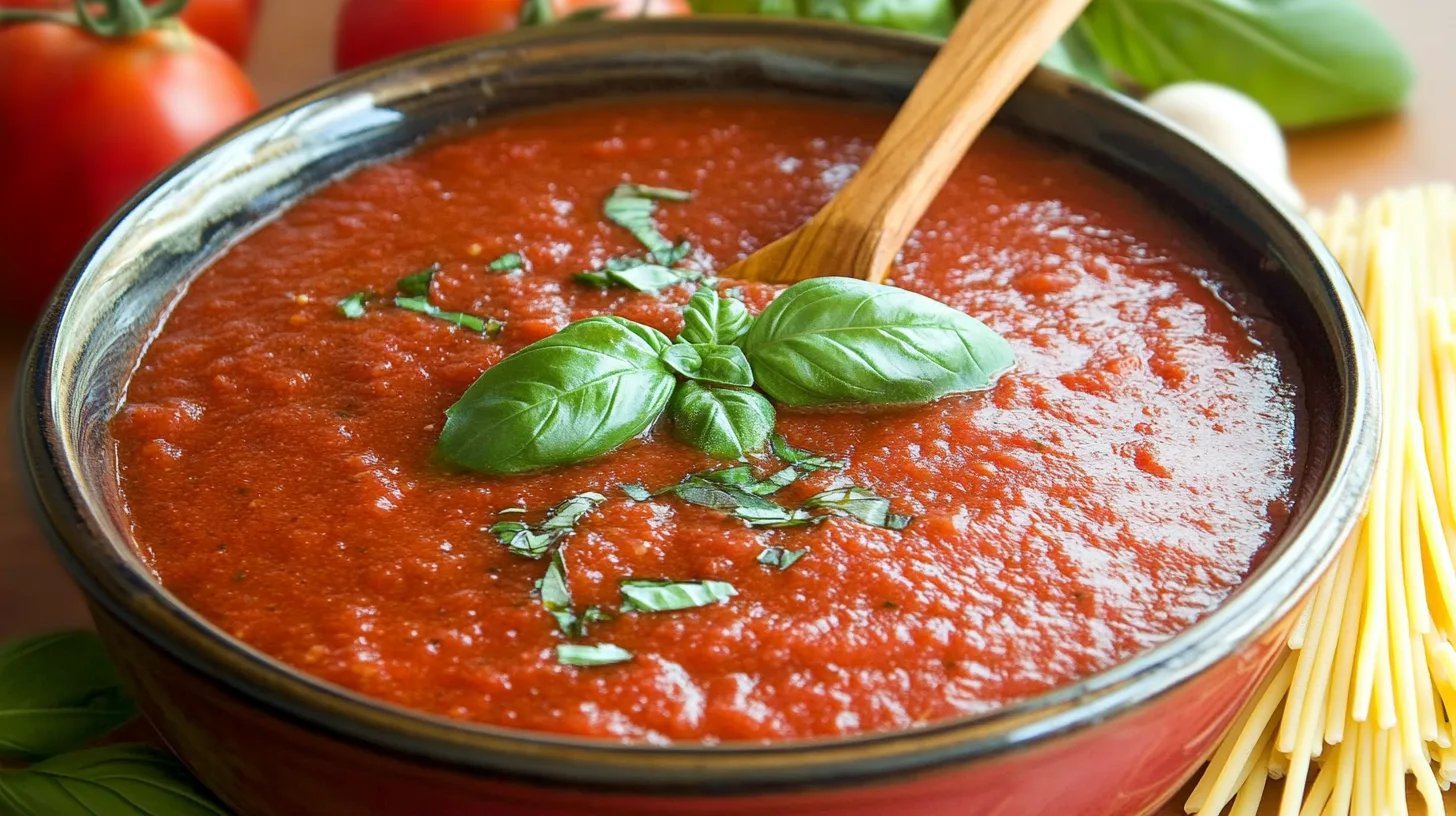Salsa de Tomate:Homemade | Easy & Delicious Recipe
Salsa de tomate is a versatile and flavorful sauce that has become a staple in kitchens around the world, particularly within Latin American cuisine. It’s more than just a condiment; it’s a part of cultural traditions and family gatherings, making it an essential ingredient for many dishes. In this ultimate guide, we will explore the history, preparation, nutritional benefits, and various uses of salsa de tomate, ensuring you have everything you need to appreciate and create this culinary masterpiece. For an exciting twist, try pairing it with a rich and savory Strozzapreti Norcina pasta, where the tangy and bold flavors of salsa de tomate can complement the creamy sauce for a truly unforgettable dish. Click here for the recipe!
The Ultimate Guide to Salsa de Tomate: A Culinary Staple
Salsa de tomate is not merely a sauce; it embodies the essence of Latin cooking. Originating from the Spanish word “salsa,” which means sauce, combined with “tomate” referring to tomatoes, this delectable concoction is a rich blend of flavors that can elevate any meal. Its simplicity allows chefs at all levels to incorporate personal twists while adhering to traditional methods.
In this section, we will delve into the definition and origin of salsa de tomate, its cultural significance across Latin America, and the key ingredients and variations that make it a unique component of various dishes.
Definition and Origin of Salsa de Tomate
The term salsa de tomate translates directly to tomato sauce in English, but its meaning transcends a mere description of ingredients. Salsa de tomate refers to several varieties of tomato-based sauces used across a multitude of cuisines, particularly in Latin America. These sauces emphasize fresh ingredients, vibrant flavors, and regional spices.
Historically, the use of tomatoes in cooking gained popularity after their introduction to Europe from the Americas in the 16th century. The Aztecs and Incas were among the first cultures to cultivate tomatoes, using them as both food and medicine. As Spanish explorers brought tomatoes back to Europe, they became a quintessential element in Mediterranean diets, eventually making their way to various Latin American countries.
This evolution gave rise to numerous regional variations of salsa de tomate, each showcasing local flavors and tastes. Whether it’s a fresh pico de gallo or a cooked salsa roja, these sauces are integral to many dishes.
Cultural Significance in Latin American Cuisine
Salsa de tomate holds a place of honor not only as a recipe but as a story that carries the heart of Latin American culture. Culinary practices differ across regions in Latin America, yet salsa de tomate acts as a unifying thread that connects diverse communities.
At family gatherings and celebrations, salsa de tomate is often present, symbolizing warmth and hospitality. It serves as the perfect accompaniment to tacos, enchiladas, tamales, and grilled meats, enhancing the flavors of these beloved dishes. Beyond the plate, it also signifies the importance of sharing and connection through food, as recipes are passed down through generations.
In countries like Mexico, salsa de tomate is more than just a side dish; it fosters a sense of pride and identity. Streets are lined with vendors selling freshly made salsas, showcasing the variety and creativity that exists within this simple sauce. Each region influences the taste profile, infusing local herbs, spices, and even fruits, ultimately producing a salsa that tells a story unique to that place.
Key Ingredients and Variations
While the basic foundation of salsa de tomate consists of fresh tomatoes, the magic lies in the array of ingredients that can be added to enhance its flavor. Common components include onions, garlic, cilantro, lime juice, and chili peppers, which contribute distinct tastes and aromas.
Variations abound, with each culture offering its twist on the classic salsa de tomate. For instance, in some regions, roasted tomatoes give a deep, smoky flavor, while others may opt for a fresher approach with uncooked ingredients.
A few popular variations include:
- Pico de Gallo: A fresh salsa de tomate combining diced tomatoes, onions, cilantro, jalapeños, and lime juice.
- Salsa Roja: A cooked version featuring pureed tomatoes, chilies, and spices, resulting in a smoother consistency ideal for frying or grilling.
- Salsa Verde: Although it differs in color, this green salsa uses tomatillos instead of red tomatoes to produce a tangy and vibrant flavor.
Regardless of the version, each type of salsa de tomate plays a critical role in enhancing the overall dining experience.
The Recipe: How to Make Salsa de Tomate at Home
Creating your own salsa de tomate at home can be a rewarding experience that allows for experimentation and personalization. With freshness as the hallmark of salsa, preparing it yourself ensures that you capture the intensity of flavor that defines this sauce.
In this section, we’ll outline the essential ingredients required for authentic salsa de tomate, provide a step-by-step preparation process, offer tips for achieving the perfect flavor profile, and highlight common mistakes to avoid during preparation.
Essential Ingredients for Authentic Salsa de Tomate
To achieve the authentic taste of salsa de tomate, selecting high-quality ingredients is paramount. Here are the core elements you’ll need:
- Fresh Tomatoes: Choose ripe and firm tomatoes, whether Roma, vine-ripened, or heirloom varieties. Their natural sweetness and acidity will form the base of your salsa.
- Onions: Yellow or white onions add depth and sweetness. Be sure to chop them finely to distribute their flavor evenly throughout the sauce.
- Garlic: Fresh garlic provides an aromatic quality, elevating the overall taste profile. You can adjust the amount based on your preference.
- Chilies: Depending on your desired heat level, select fresh jalapeños, serranos, or other chilies. Always taste before adding to ensure the right amount of spice.
- Cilantro: This herb adds a burst of freshness and is essential for that classic salsa flavor. If you’re not a fan, feel free to substitute parsley.
- Lime Juice: Freshly squeezed lime juice enhances the flavors and balances the acidity of the tomatoes.
- Salt: Use salt judiciously to enhance the overall flavor without overwhelming the natural taste of the ingredients.
With these fundamentals, you can customize your salsa de tomate by adding additional spices, fruits (like mango or peach), or even different types of vinegar for a unique twist.
Step-by-Step Preparation Process
Making your own salsa de tomate is an enjoyable process that can be done in a matter of minutes. Follow these simple steps to craft your delicious sauce:
- Wash and Prepare the Ingredients: Rinse your tomatoes, chilies, and herbs thoroughly under cold water. Remove the stems, seeds (if desired), and chop them into smaller pieces for easier blending.
- Combine Ingredients: In a mixing bowl, combine the chopped tomatoes, onions, chilies, and minced garlic. Add the chopped cilantro and freshly squeezed lime juice, along with salt to taste.
- Mix Thoroughly: Use a spoon or spatula to mix the ingredients until evenly combined. Taste your salsa, adjusting lime juice and salt as needed for balance.
- Let It Rest: Allow the salsa to sit for about 15-30 minutes to let the flavors meld together. This resting time helps the ingredients develop a more harmonious taste.
- Serve or Store: Enjoy your fresh salsa de tomate immediately or store it in an airtight container in the refrigerator for up to a week.

Tips for Achieving the Perfect Flavor Profile
Achieving the ideal flavor in your salsa de tomate involves understanding how each ingredient contributes to the overall taste. Here are some tips to help you master this culinary art:
- Use Seasonal Ingredients: When tomatoes are in season, they are at their most flavorful. Try to source local and organic tomatoes whenever possible for superior taste.
- Balance Acidity and Sweetness: If you find your salsa too acidic, consider adding a pinch of sugar or honey to balance the flavors. Conversely, if it’s too sweet, add more lime juice or salt.
- Experiment with Texture: For chunkier salsa, hand-chop the ingredients instead of using a food processor. A smooth salsa can be achieved by blending the ingredients, but be careful not to over-process, leading to a watery consistency.
- Layering Flavors: Consider roasting your tomatoes and chilies for a deeper flavor profile. Charred ingredients can impart a delightful smokiness that elevates your salsa.
Common Mistakes to Avoid
Even the most experienced cooks can fall into traps when making salsa de tomate. Here are some common errors to watch out for:
- Underseasoning: Always taste your salsa before serving. Insufficient seasoning can lead to blandness, so don’t hesitate to adjust salt and lime juice accordingly.
- Ignoring Freshness: Utilizing stale or overripe ingredients can compromise flavor. Always aim for fresh, vibrant produce to create a bright salsa.
- Overlooking Texture: Finding the right balance between chunky and smooth is crucial. Too much blending can create a sauce that’s too liquid, while too little can result in an unpleasant mouthfeel.
By paying attention to these tips, you’ll be well on your way to crafting the perfect salsa de tomate every time.
Nutritional Benefits of Salsa de Tomate
Salsa de tomate is not only delicious but also packed with nutritional benefits. With its primary ingredient, tomatoes, being low in calories and rich in vitamins, this sauce can contribute positively to a balanced diet.
In this section, we’ll explore the health benefits of tomatoes, compare salsa de tomate to other sauces, and discuss how this flavorful option fits into a balanced diet.
Health Benefits of Tomatoes
Tomatoes are nutrient powerhouses that offer a multitude of health benefits. They are rich in vitamins C and K, potassium, and folate, all of which play vital roles in maintaining overall health.
One standout component of tomatoes is lycopene, a powerful antioxidant known for its potential to combat chronic diseases such as cancer and heart disease. Lycopene is more readily absorbed by the body when tomatoes are cooked, making salsa de tomate, especially roasted versions, an excellent source of this beneficial compound.
Moreover, tomatoes contain hydration-promoting water content, which supports skin health and aids digestion. Consuming salsa de tomate can also help increase your vegetable intake, contributing to better overall nutrition.
Nutritional Comparison with Other Sauces
When comparing salsa de tomate to other popular condiments, it stands out as one of the healthier options available. Many store-bought sauces can be high in sugar, preservatives, and unhealthy fats, which can detract from their nutritional value.
Here’s how salsa de tomate measures up against some common sauces:
- Ketchup: While ketchup is tomato-based, it often contains added sugars and high fructose corn syrup, making it less healthy than fresh salsa de tomate.
- Barbecue Sauce: This sauce tends to be high in sugar and sodium, while salsa de tomate typically has fewer calories and doesn’t rely on artificial flavors or additives.
- Creamy Sauces: Many creamy dressings and sauces pack a hefty caloric punch due to their fat content, whereas salsa de tomate is low in calories and fat-free.
Opting for salsa de tomate as a condiment allows you to enjoy bold flavors while consuming fewer calories and additives.
How Salsa de Tomate Fits into a Balanced Diet
Salsa de tomate can easily fit into a balanced diet, serving as a flavorful addition to meals without compromising nutritional goals. Its versatility allows it to complement a wide range of foods, from grilled meats and vegetables to grains and legumes.
Incorporating salsa de tomate into your meals can enhance flavor without overwhelming your plate with empty calories. It can be a great replacement for heavier sauces or dressings, contributing vibrant taste without added fat or sugars.
Additionally, salsa de tomate pairs beautifully with whole foods, encouraging increased vegetable intake and providing the necessary nutrients your body craves. By utilizing salsa de tomate creatively, you can transform ordinary meals into exciting culinary experiences that align with your dietary choices.
Pairings and Uses for Salsa de Tomate
The versatility of salsa de tomate makes it an essential component in countless culinary applications. From traditional dishes to innovative creations, there is no shortage of ways to incorporate this sauce into your cooking.
In this section, we will explore traditional dishes that pair perfectly with salsa de tomate, creative applications beyond the plate, and tips for proper storage and shelf life.
Traditional Dishes That Complement Salsa de Tomate
Salsa de tomate is a beloved accompaniment to a variety of traditional Latin American dishes. Here are a few classics where this sauce shines:
- Tacos: Whether filled with shredded chicken, beef, or sautéed vegetables, tacos topped with fresh salsa de tomate bring a burst of flavor and texture.
- Enchiladas: Rolled tortillas filled with meat or cheese get a facelift when smothered in salsa de tomate before baking, creating a delicious and comforting dish.
- Tamales: These masa-based favorites are often served with a generous dollop of salsa de tomate, adding moisture and richness to every bite.
- Grilled Meats: From carne asada to grilled shrimp, drizzling salsa de tomate over grilled meats enhances the dish’s smokiness and brings brightness to the palate.
- Breakfast Dishes: Various breakfast staples like huevos rancheros or chilaquiles showcase salsa de tomate as a crucial element, providing a flavorful kick to morning meals.
Creative Applications Beyond the Plate
Salsa de tomate’s versatility extends beyond traditional uses, making it an exciting ingredient to experiment with in the kitchen. Here are some creative applications:
- Marinades: Use salsa de tomate as a marinade for chicken or fish before grilling. The acidity from the tomatoes and lime juice tenderizes the protein while infusing it with flavor.
- Dipping Sauce: Serve salsa de tomate as a dipping sauce alongside tortilla chips, cheesy quesadillas, or grilled vegetables for a satisfying snack.
- Pasta Sauce: Turn salsa de tomate into a quick pasta sauce by heating it and tossing it with your favorite noodles, adding protein or vegetables as desired.
- Pizza Base: Instead of traditional pizza sauce, spread salsa de tomate on your dough for a fresh and flavorful pizza topping, complemented with cheese and your favorite toppings.
- Soups and Stews: Incorporate salsa de tomate into soups or stews for extra depth of flavor. It works wonders in chili or as a base for gazpacho.
Storage and Shelf Life of Salsa de Tomate
Proper storage is crucial to maintaining the freshness and flavor of your homemade salsa de tomate. Here are some tips to ensure it stays delicious:
- Refrigeration: Store salsa de tomate in an airtight container in the refrigerator. It can last up to a week, allowing time for flavors to meld and intensify.
- Freezing: If you want to preserve your salsa for longer, consider freezing it in ice cube trays or freezer-safe bags. Thaw portions as needed for future recipes.
- Signs of Spoilage: Always check for signs of spoilage, such as off smells, mold, or changes in color or texture. Discard any salsa that appears questionable.
By following these guidelines, you can savor your homemade salsa de tomate for days while minimizing waste.

Conclusion
Salsa de tomate is undeniably a culinary gem, offering a rich tapestry of flavors that enhance countless dishes. From its origins in Latin America to its status as a global staple, this sauce embodies the spirit of creativity and tradition in cooking.
Whether you’re a novice or an experienced chef, creating your own salsa de tomate allows for personal expression while celebrating the ingredients’ freshness and vibrancy. Embracing its nutritional benefits and versatility opens the door to endless culinary possibilities, transforming ordinary meals into extraordinary experiences.
As you embark on your journey with salsa de tomate, remember that the beauty of this sauce lies in its adaptability. Feel free to explore, experiment, and enjoy all that this delightful creation has to offer.
Craving a hearty, flavorful meal? Try this simple chip steak recipe, a perfect way to enjoy a tender, juicy steak with just a few easy steps. Click here to discover how to make this delicious dish!

